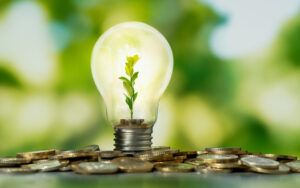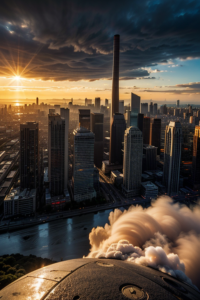Green roofs - Vision for the Future
The design of the buildings changed over time, but it should be noted that the function of the building always remained the same: to protect, to give comfort, warmth in winter and coolness in summer. However, in recent years the impact of buildings on the environment and solutions that include green roofs are becoming more important.
With the development of a broader view of sustainability, it is crucial to remember that, from the point of view of the life cycle of the building, each building impact on the environment stems from its energy consumption while in use, and the use of renewable energy and the use of sustainable materials.
Green roofs are going a step further of relevance to contemporary architecture and adds a new value the role of buildings in urban planning. They are designed not only for it to return to a natural element in the urban environment, but also to provide solutions to important problems such as the urban heat island effect and atmospheric water treatment. Titan Contractors say, “Manufacturers now offer homeowners new products made from recycled materials and products that are better for the environment. Homeowners can work with Arlington roofing contractors to ensure that they select the right products to make their homes more environmentally friendly.”
The use of green roofs has multiple positive effects on the quality of life in urban areas.
- It reduces the total energy consumption for heating and cooling of the facilities
- Contributes to increase the area under vegetation in urban areas
- It reduces the urban heat island effect in summer
- It affects the quality and quantity of atmospheric waters
- They have a significant impact on the pollution of air, soil, water
- It is not negligible their impact on reducing the high noise levels in urban areas
A very important fact is that the roof surface occupy 20-25% of the total urban area. So promotion of the application of green roofs can significantly contribute to the quality of life in urban areas.
- It contributes to environmental and aesthetic values of urban areas
- Provides protection against ultraviolet radiation (60% of the radiation is absorbed by plants and land)
- The application of green roofs is increasing vegetation in urban areas
In the long term green roofs are economically feasible / sustainable.
- Under the green roof, internal temperature without additional cooling are 3-5 degrees Celsius lower than the outdoor temperature.
Installing a green roof on the five-story building provides a 1-15% savings in annual energy.
- Scheduled raising green roofs can reduce the increase in temperature of the object and up to 20 degrees Celsius and save up to 80% of the energy needed for cooling or heating.
- Applying a green roof extends the life of his almost triple, roofing material is protected from mechanical damage, ultraviolet radiation, extreme temperatures, resulting in reduced maintenance costs and repairs.
- Green roofs can provide an alternative to the development of urban agriculture. It can reduce the urban character of the environment through building a local food system and to ensure independence in food resources.
Types of green roofs
The types of green roofs are divided into two main groups:
- Extensive green roofs
- Intensive green roofs
Extensive green roofs
The essence of this is that the roof has a natural, soft vegetation that requires minimal maintenance.It is designed standard multilayer design of extensive green roof that includes layers of different functions: a layer that allows the growth of vegetation, filtering and drainage. Watering of rooted plants is not necessary, while new plants during dry periods may require watering.
As long as the desired vegetation does not cover the projected roof surface after one or two seasons, it needs a little more intense maintenance.After that It needs maintenance only twice a year and an annual tour of the roof (it is recommended in early spring and autumn).
Intensive green roofs
They give a wide range of design options including the possibility of creating a garden on the roof. They can create spaces for staying, even it is possible planting of trees. If the vegetation layer is deep enough, are providing enough water and nutrients than conditions are created for the survival of plants and vegetation as well as on the land.
The planning of such a roof requires specialist knowledge, particularly in the selection of appropriate plants. Maintaining that require intensive green roofs is much larger and is demanding, as well as maintenance of gardens in the land.
The green roof reduces the impression of overheating in the summer because it increases the humidity and provides thermal protection.With greening roofs tenants in summer protect attic spaces from overheating. Tests have shown that climate value in rooms under grassed roof is equal to rooms on the ground floor of buildings.
The vegetation on the roof absorbs dust and harmful gases. The plants so treated and refined air that people breathe.
Typical summer heat in the attic, which makes living and working in these areas almost impossible, under quality green roofs is not feeling. These roofs can be a good substitute for the less vegetation on the ground, globally and locally contribute to improving the microclimate, and thus a more comfortable and healthier environment in which we live.
Green on the roof improves sound insulation o rooms because by absorbing airborne sound decreases its transmission in the attic spaces. Thus, green roofs can make life more comfortable in buildings and private homes that are close to the airport, factories, discotheques. The greenery on the roof reduces the effect of electromagnetic waves emitted by portable radio stations and mobile phones. And as finance is concerned, although it may be more expensive initially, green roof saves on maintenance of the building or house.
The green roof protects the waterproofing on the roof of aging under the influence of sunlight, temperature extremes and mechanical damage. In this way, and, extends its lifetime. Also on the rehabilitated buildings, green roof enhances the effect of the existing thermal insulation, which can save 3 to 10% on heating bills in winter, but also on the cost of air conditioning in summer.
Green roof and retains rainwater and slows down their flow into the sewer. Depending on the type of green roof, under the roof system can retain up to 90 percent of average annual rainfall. Much of the water with the breathing of the plants and evaporation from the substrate goes back into the natural flow of water circulation. The remaining of excess water drains from the roof with a time delay and thus a year in the system of rainwater reaches over 50 percent of water per square meter of green roof less.
That green roof is one of the possibilities for the development of urban areas time will surely show. Sustainable urban development in the future will not be possible without the use of green roofs, green infrastructure, sustainable urban system for wastewater, … what will provide multiple benefits to the cities in the future (resistance to climate change, mitigating the effects of floods, droughts, noise, phenomena of thermal islands, reduce air pollution, improve energy efficiency and quality of life.)









